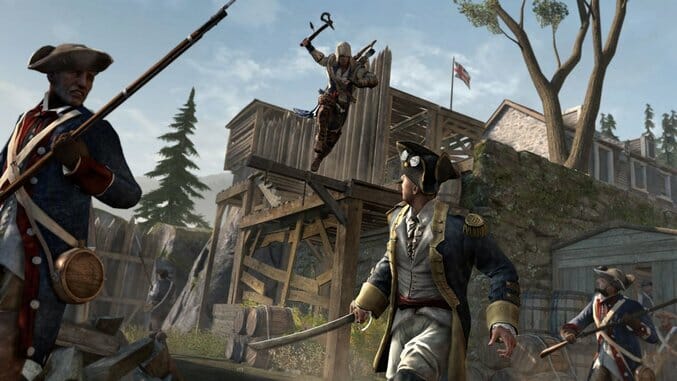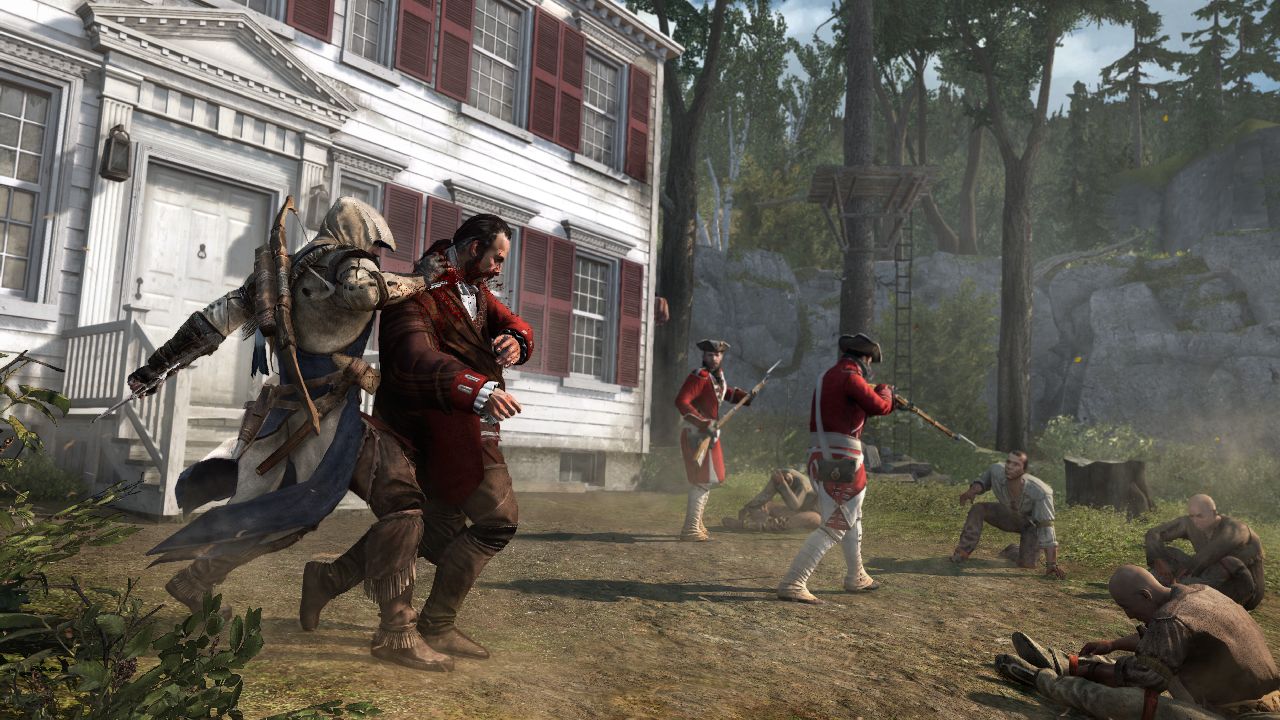
The Assassin’s Creed games have a lot in common with the secret societies they portray. They are obscure, trading in mystery with an elaborate Russian doll narrative; they are steeped in tradition, portraying a pageant of history replete with double meanings; and, most of all, they are divisive, inspiring fervent love, scorn and confusion in turns.
The first game, in retrospect more a proof of concept than a fully realized game, followed Altair’s adventure in the Holy Land. Assassin’s Creed II introduced players to Ezio, an assassin of the Italian Renaissance, and his story continued through two additional games, Brotherhood and Revelations. The common thread throughout the entire series has been Desmond, a man living in 2012 who is using a machine called an Animus to re-live the lives of his ancestor’s memories to find the key to stopping an imminent, cosmic apocalypse. Each title marked an evolution-more features, refined controls and deeper story.
Assassin’s Creed III, the latest installment, does not reinvent the series. It embraces the core ideas-parkour, historical drama, conspiracy theories, derring-do-and pushes them further. If you have loved those things in the past, you will love them even more here. If you hate the sci-fi infused framing story with its flickering digital artifacts, or the repetitive objective based action, or the slow-burn multiplayer, well, there is a lot more to gnash your teeth over. And, while Assassin’s Creed III does its best to be a friendly entry point into the franchise, it is hard to imagine a new player being anything but baffled by the weight of lore put forth over the course of four full games, a comic mini-series, an animated short and several mobile and handheld titles.
This installment puts players in the shoes of Connor, a half English and half Mohawk assassin who finds himself caught up in the key events of the American Revolution while trying to protect the lands of his tribe. The action takes him from the forests of the frontier to the colonial cities of New York and Boston, as well as to the Caribbean aboard the schooner Aquila.
A seemingly endless parade of new features attempt to make the world come alive. Of them, the naval missions are easily the best. As the captain of the Aquila, you battle other ships, the weather and the sea itself. They’re tightly wrought and extremely dynamic vignettes, full of adventure and challenge—they play so well and look so good that I’d welcome an entire game like this on the high seas.

Other features fare less well. Recruiting assassins and sending them on missions, a favorite innovation from Brotherhood, feels segregated in Assassin’s Creed III despite giving recruits defined histories and personalities. As satisfying as running through the treetops is, it is laughably difficult to get into them—only certain trees are climbable at the base. And there are more new wrinkles, oscillating between the fitfully interesting and the downright frustrating.
Take the new crafting system, for example. Born out of the property management introduced in Assassin’s Creed II, you control a New England homestead and the people who work the land surrounding it. Those people can be tasked with using natural resources (say, lumber) to make refined products (a barrel). You can then, in turn, ship those items to market on a merchant caravan. There are variables like risk, profit and game time that are determined by the destination.
The homestead itself is nice base of operations, a corner of the game that feels like home, which your actions have lasting effects on. But as the center of a game’s economic system, it is completely hobbled. You can only ship three items at a time, drastically reducing the amount of money to be made, especially in light of how long the shipping times are. There are easier ways to make money, as well, either by finding hidden chests in the world or simply bringing the raw crafting materials to market directly via Connor. Finally, aside of ship upgrades and new weapons, there isn’t much to spend your money on once you earn it.
The problem with the homestead and all the extra features, even the delightful naval battles, is that none of them feed back into the main game, or even to each other. They are stray threads, leading nowhere. There is no cause and effect. They wind up being distracting. Pointless, even.
That main game remains a highly refined, violently satisfying historical drama, and an absolute giddy joy to play. Even things as simple as character animation-like the way movements feel affected by weight and velocity-are a substantial part of the equation. Thankfully, the superfluous bits are easy to ignore or embrace as you wish. In the end, the point of playing Assassin’s Creed III is figuring out how you want to play Assassin’s Creed III.
Assassin’s Creed III was developed by Ubisoft Montreal and published by Ubisoft. Our review is based on the Xbox 360 version. It is also available for the PlayStation 3, PC and Wii U.
Stu Horvath is the man behind the geek culture website Unwinnable. He has written for the New York Daily News, Complex, Kill Screen Magazine, Wizard Magazine, Crispy Gamer, and Joystiq.